Fractions Assessment
- Grade: Grade 4
Activity type: Printable
To save results or sets tasks for your students you need to be logged in. Join Now, Free
Fractions Assessment
- Course
Mathematics - Grade
Grade 4 - Section
Fractions - Outcome
Tenths and hundredths - Activity Type
Printable - Activity ID
26598

